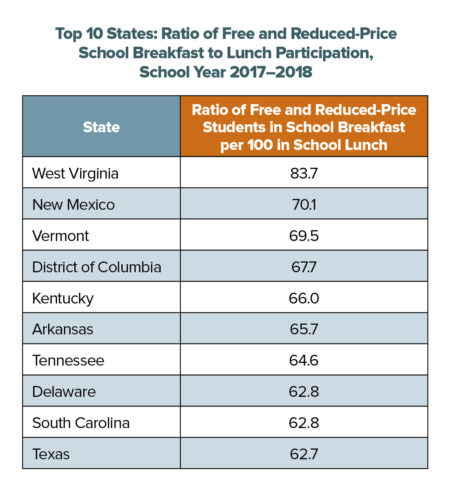Media Contact:
Emily Pickren
epickren@frac.org
202-640-1118
West Virginia at Number One; Utah Ranks Last
 WASHINGTON, February 13, 2019 — More low-income children across the country are getting the nutrition they need to learn and thrive through the School Breakfast Program, according to the annual School Breakfast Scorecard, released today by the Food Research & Action Center (FRAC).
WASHINGTON, February 13, 2019 — More low-income children across the country are getting the nutrition they need to learn and thrive through the School Breakfast Program, according to the annual School Breakfast Scorecard, released today by the Food Research & Action Center (FRAC).
On an average school day during the 2017–2018 school year, nearly 12.5 million low-income students participated in the national School Breakfast Program, an increase of 1.2 percent over the prior school year. In the 2017–2018 school year, 4 million more low-income children received school breakfast on an average day than a decade ago in the 2007–2008 school year.
The Scorecard ranks states and the District of Columbia on the basis of the rate of participation of low-income children in the School Breakfast Program compared to the rate of participation of low-income children in the National School Lunch Program. West Virginia topped the list, with New Mexico and Vermont coming in second and third, respectively. West Virginia and New Mexico also exceeded FRAC’s goal for states to reach 70 low-income children with school breakfast for every 100 who ate school lunch. FRAC’s interactive school breakfast map shows state-by-state participation data.
“The benefits of school breakfast are numerous — less hunger, better test scores, improved student health, and fewer distractions from hunger during classroom learning,” said Jim Weill, president, Food Research & Action Center.
The report also reconfirms that when breakfast is moved out of the cafeteria and served after the first bell, participation increases and more children reap the benefits. New York’s large increase in the number of low-income students participating in school breakfast in school year 2017–2018 was largely driven by New York City’s rollout of a districtwide breakfast after the bell program and its implementation of community eligibility. More than 56,000 additional low-income students across the state ate school breakfast compared to the prior school year, the largest state increase in the number of students in the nation.
Utah remained the lowest-performing state on the Scorecard, serving breakfast to fewer than 40 low-income students for every 100 who participated in school lunch. Eight additional states — Hawaii, Illinois, Iowa, Nebraska, New Hampshire, South Dakota, Washington, and Wyoming — reached less than half of the low-income students who ate school lunch. These states fell way below the national average of 57 low-income children participating in school breakfast for every 100 who ate school lunch.
The Scorecard also details the high fiscal cost of low participation in the School Breakfast Program by including the amount of money that states left on the table in the 2017–2018 school year by not reaching more eligible children with school breakfast. Large states, such as California, Florida, and New York, would have collectively brought in an additional $255 million in federal resources had they met FRAC’s 70-to-100 goal.
Today, FRAC also released School Breakfast: Making it Work in Large School Districts, a companion report to the Scorecard. Of the 76 large school districts surveyed for this report, 21 achieved FRAC’s benchmark of serving 70 low-income children with school breakfast for every 100 receiving school lunch. A number of the top-performing school districts — Los Angeles Unified School District, San Antonio Independent School District, and Newburgh Enlarged City School District, among others — serve a particularly high proportion of students from low-income households.
“We commend the states and school districts that have implemented effective strategies to increase participation such as serving breakfast after the bell and offering breakfast at no charge to all students. We strongly encourage others to follow their lead,” said Weill.
Read the Scorecard and the Large School District reports.
###
The Food Research & Action Center is the leading national nonprofit organization working to eradicate poverty-related hunger and undernutrition in the United States.

